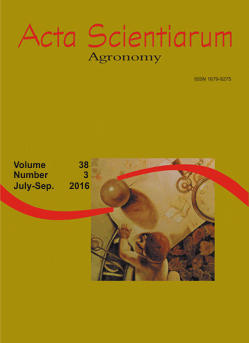<b>Genetic effects for controlling stripe rust (<i>Puccinia striiformis</i> f. sp. <i>tritici</i>) resistance in wheat through joint segregation analysis
Resumo
Mixed inheritance analysis using joint segregation analysis (JSA) for stripe rust (Puccinia striiformis f. sp. tritici) resistance was carried out in six basic populations (P1, F1, P2, BC1, BC2 and F2) of four wheat crosses (Hashim-08 × LU-26, Farid-06 × Shafaq, Parula × Blue Silver, TD-1 × D-97603) during crop season 2009 to 2012. Genes controlling stripe rust resistance were assessed by using area under disease progress curve (AUDPC). The AUDPC was controlled by mixed two additive-dominant-epistatic major genes plus additive-dominant-epistasis of polygenes in cross Hashim-08 × LU-26 (model E), while in Farid-06 × Shafaq, it was controlled by mixed two major additive-dominant genes plus additive-dominant polygenes (model E-2). In cross Parula × Blue Silver, the AUDPC was managed by additive, dominance and epistasis of two major genes (model B-1), however, it was controlled by mixed one major gene and additive dominant polygenes in cross TD-1 × D-97603 (model D-1). Genetic variation and heritability was higher in major genes than polygene for all the crosses showing that AUDPC was mainly controlled by major genes. The genetic behavior of the AUDPC revealed that stripe rust resistance was controlled by mixed interaction of one to two major genes plus polygenes.
Downloads
DECLARAÇÃO DE ORIGINALIDADE E DIREITOS AUTORAIS
Declaro que o presente artigo é original, não tendo sido submetido à publicação em qualquer outro periódico nacional ou internacional, quer seja em parte ou em sua totalidade.
Os direitos autorais pertencem exclusivamente aos autores. Os direitos de licenciamento utilizados pelo periódico é a licença Creative Commons Attribution 4.0 (CC BY 4.0): são permitidos o compartilhamento (cópia e distribuição do material em qualqer meio ou formato) e adaptação (remix, transformação e criação de material a partir do conteúdo assim licenciado para quaisquer fins, inclusive comerciais.
Recomenda-se a leitura desse link para maiores informações sobre o tema: fornecimento de créditos e referências de forma correta, entre outros detalhes cruciais para uso adequado do material licenciado.




















































